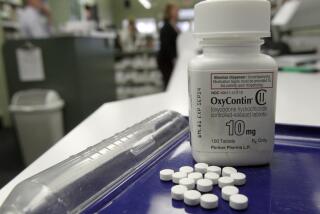About 70 million Americans could take statins under new guidelines
- Share via
The number of Americans taking cholesterol-lowering statin drugs is set to double under new guidelines unveiled Tuesday by the American College of Cardiology and the American Heart Assn.
The goal of prescribing statins to as many as 70 million people is to reduce the incidence of heart attacks and strokes in the United States, not merely to get patient’s LDL cholesterol – the “bad” kind that’s most closely linked to disease risk – into an ideal range, experts said.
The new game plan for statins represents a stark shift from approaches embraced by cardiologists and primary care physicians for most of the past decade. Now, doctors will be urged to treat a wider range of healthier patients, including those likely to suffer stroke or heart disease as they age.
The new guidelines distinguish between patients who would benefit most from high-dose statin therapy and those who can take a lower dose less likely to cause side effects, such as muscle fatigue, a slight rise in blood sugar and, in rare cases, hemorrhagic strokes and a toxic breakdown of muscle tissue called rhabdomyolysis.
Cholesterol is essential for digestion, hormonal balance and cell function, but at high concentrations can gum up arteries. Statins reduce cholesterol by blocking the liver’s production of the waxy substance. Americans spent $21.3 billion on cholesterol-lowering medications in 2010, including statins marketed under such brand names as Crestor, Lipitor and Zocor.
Under the new guidelines, physicians should prescribe statin medications to all patients with high odds of suffering a heart attack or stroke in the short-term — that is, those who have had such an event already, patients with Type 2 diabetes, and those with exceptionally high levels of LDL cholesterol linked to familial risk. But the guidelines also recommend that patients with a 7.5% risk of suffering a stroke or heart attack over the next decade be prescribed statin medication as well.
Until now, treatment with cholesterol-lowering drugs in the United States has generally been limited to patients judged to have a 20% probability of heart attack — roughly 36 million Americans. The new, expanded treatment guidelines would roughly double that figure, its authors said.
That increase has been driven in part by the inclusion of people at risk of suffering ischemic stroke, a reduction in blood flow to the brain caused by arteries narrowed by plaque build-up or a breakaway blood clot.
Taking a statin drug has been shown to reduce a patient’s likelihood of stroke as well as heart attack. But the new guidelines mark the first time that patients most at risk of stroke — including women, African Americans and the very elderly — have explicitly been counted in the tally of those who could benefit from statin therapy.
Dr. Neil Stone, chief author of the practice guideline on cholesterol management, argued that Americans’ health would benefit more from a vigorous approach to identifying and treating patients at risk of heart attack and stroke than from energetic efforts to reach specific cholestrol targets.
“Statins treat risk, not only cholesterol,” said Stone, a cardiologist and professor at Northwestern University’s Feinberg School of Medicine.
In proclaiming statins a physician’s most effective tool for preventing heart attacks and strokes, the writers of the new guidelines downplayed concerns about the medications’ side effects.
“There are pros and cons to this tectonic shift,” said Dr. Steven Nissen, an influential Cleveland Clinic cardiologist who was not involved in drafting the new recommendations.
The guidelines will align physician practices with a wealth of new research showing what works — and what doesn’t — in preventing heart attacks and strokes, Nissen said. The result should be fewer premature deaths and fewer patients disabled by heart attacks and strokes – although it will take years for such reductions to be tallied, he said.
Following the recommendations “will require new thinking” on the part of doctors, Nissen added. Now that statins have been judged to benefit a wider swath of Americans, physicians will have to switch to new tools to identify them — including an online “risk calculator” also unveiled Tuesday. And they’ll be making the case for statins to patients who have not considered themselves candidates before now, he said.
With virtually all statin medications now available in generic form, patients and physicians will be less likely to resist the recommendations on financial grounds, Nissen said.
The new guidelines were published under the title “Treatment of Blood Cholesterol to Reduce Atheroschlerotic Cardiovascular Risk in Adults.”
ALSO:
FDA’s trans fat decision: An opening for regulating salt, sugar?
Time to end the war against saturated fat?
One-quarter of deaths from heart disease, stroke avoidable, CDC says







